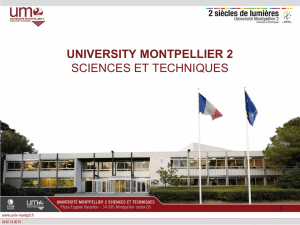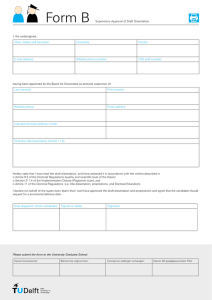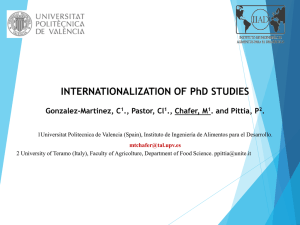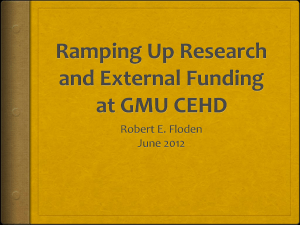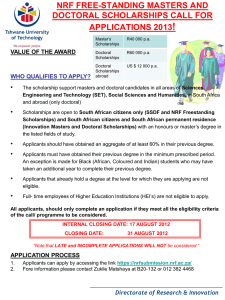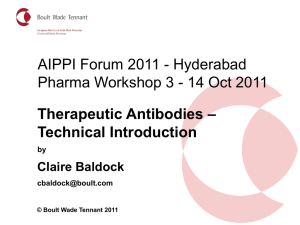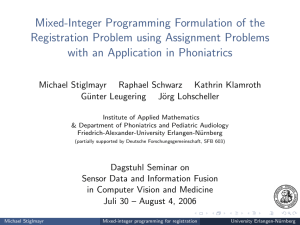History_diversity_models - Erlangen (Hans
advertisement
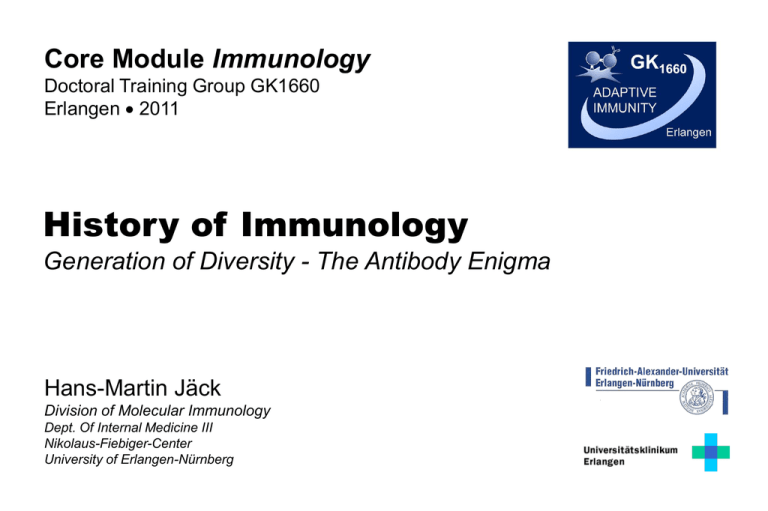
Core Module Immunology Doctoral Training Group GK1660 Erlangen 2011 History of Immunology Generation of Diversity - The Antibody Enigma Hans-Martin Jäck Division of Molecular Immunology Dept. Of Internal Medicine III Nikolaus-Fiebiger-Center University of Erlangen-Nürnberg TIME LINE - History of Immunology Discovery of cells and germs (1683 - 1876) Prevention of Infection (1840 – today) Start of Immunology (1796-1910) The antibody problem: Immunochemistry (1910 - 1975) Self-/non-self discrimination (1940 – today) Generation of Diversity G.O.D. (1897 and 1976s) Discovery of B and T cells (1960s) The molecular revolution (1976 – today) Models to Explain Immunity - Specifity & Inducibility - MODELS: Instruction versus Selection Precursor of an antibody-forming cell (AFCP) is not precommitted, but has the potential of making any one of a millions of different antibodies. AFCP) are precommitted to producing antibody of a particular specificity. Doctoral Training Group GK1660 - University of Erlangen-Nürnberg 5 Ehrlich‘s Side Chain Theory Paul Ehrlich (1854-1915) Germany Nobel price Medicine 1908 Klin Jahrb. 6:299. (1897) Proceedings of the Royal Society (London) 66, 424-448 66, 424-448 Doctoral Training Group GK1660 - University of Erlangen-Nürnberg 7 1st Selection Model (Ehrlich 1897 und 1900) Sidechain Toxin Toxin binds to specific side-chain (receptor) on cell surface like ´“a key finds ist lock Side chain-toxin complex „falls off“ from cell. Cell compensates for loss with overproduction of this side chain More specific side-chains accumulate on cell surfcae Overcrowed sidechains are released as soluble free sidechains (anti-toxin) Released antitoxins neutralize toxins Side chains (described in 1900 as “receptor”s) on the surface of cells could bind specifically to toxins – in a "lock-and-key" interaction (Emil Fischer) and that this binding reaction was the trigger for the production of soluble antitoxins (antibodies). Doctoral Training Group GK1660 - University of Erlangen-Nürnberg 8 Key-Lock (1897) and Receptor (1900) Ehrlich, P (1897). Wertbemessung des Diphterieheilserums - Grundlagen. Klin Jahrb. 6:299 Ehrlich & Morgenroth (1900). Über Haemolysine-dritte Mitteilung. Berliner Klinische Wochenschrift 453 Doctoral Training Group GK1660 - University of Erlangen-Nürnberg 9 Emil Fischer • Synthesized (+) glucose, fructos and mannose (1890) from glycerol and purines (1898) including the first synthesis of caffeine. → Nobel Prize for Chemistry in 1902 • 1884 (in Erlangen), coined the name “purins” for a class of active substances (caffeine and theobromine) in tea, coffee, cocoa Emil Fischer 1852-1919 Germany Nobel Prize Chemistry 1902. • Discovered proline and hydroxyproline • 1890 "Lock and Key Model" to explain the substrate and enzyme interaction. Erlangen (1881-88) Doctoral Training Group GK1660 - University of Erlangen-Nürnberg 11 Emil Fischer • 1891 Fischer projections o two-dimensional representation of a three-dimensional organic molecule by projection o originally proposed for the depiction of carbohydrates and In Berlin • 1901 Synthesis of the first dipeptide glycylglycine (with Ernest Fourneau) • 1919 Commits suicide (as his 2. son) Doctoral Training Group GK1660 - University of Erlangen-Nürnberg 12 Explanation of various antibody activities o Lysine o Agglutinine o Antitoxine http://www.imedo.de/medizinlexikon/ehrlich-seitenkettentheorie Doctoral Training Group GK1660 - University of Erlangen-Nürnberg 13 Ehrlich‘s Summary: Side-Chain Theory Ehrlich (1908). Über Antigene und Antikörper. Einleitung in „Handbuch der Immunitätsforschung“. P.1 -10 Very nice overview about the knowledge of antibody and antigen in 1908. Doctoral Training Group GK1660 - University of Erlangen-Nürnberg 14 Summary: Side-Chain Theory A B D Keypoints C E o All cells express on their surface sidechains (receptors) that bind toxin. Side chains‘ physiologic function is to to take up food. (A ff) o Cell overproduces the partcular sidechain (B) and releases it into the bloodstream (C) o Soluble sidechain neutralises toxin (C), or recruits complement (D), agglutinates pathogens (D as membrane-bound form) or even opsonises pathogen (activity only known since 1905) Explains o all oberserved activities of antibodies (agglutinins, lysins, antitoxins and precipitins and even opsonins) o Inducibility (only present in blood is soluble form after immunisation) o Specificity (only antibodes to particular pathogen) Problem o Enough space on a cell for all possible „toxins“ and pathogens? Doctoral Training Group GK1660 - University of Erlangen-Nürnberg 16 Landsteiner: Hapten Carrier Concept • Antibodies can be produced againts any small organic compounds and even arsenate, but only if they are coupled to protein carrier • Hapten alone does not induce antibodies but it will bind to antibodies Antigenicity ↔ Immunogenicity Doctoral Training Group GK1660 - University of Erlangen-Nürnberg 27 Landsteiner: Antibodies against Haptens Serum derived from immunization with 3-aminobenzenesulfonic acid exhibits Landsteiner K. Die Spezifizitat Der Serologischen Reaktionen. Springer-Vertag:Berlin, 1933. Landsteiner, K. The Specificity of Serological Reactions; Harvard University Press: Cambridge, Massachusetts, 1945, p 169. (Original experiments were performed in the 20s) Doctoral Training Group GK1660 - University of Erlangen-Nürnberg 28 Landsteiner: Antibodies againts Enantiomers Landsteiner K. Die Spezifizitat Der Serologischen Reaktionen. Springer-Vertag:Berlin, 1933. Landsteiner, K. The Specificity of Serological Reactions; Harvard University Press: Cambridge, Massachusetts, 1945, p 169. (Original experiments were performed in the 20s) Doctoral Training Group GK1660 - University of Erlangen-Nürnberg 29 Landsteiner‘s Conclusion: Since he could get antibodies to arsenate as well as many other chemical groups coupled to proteins, Landsteiner reasoned that: Aus: GOLUB & Green: Immunology, a Synthesis, 2nd edition,Sunderland, MA, USA, S. 7-17 Doctoral Training Group GK1660 - University of Erlangen-Nürnberg 31 Haurowitz 1930: Paradigm change p. 8 Antigen must instruct formation of specific antibody Since Landsteiner‘s work (1920s) demonstrated that antibodies can be raised against many substances that do not occur in living organisms, Ehrlich‘s side chain theory fell in disfavor and was forgotten between 1920 and 1930 Doctoral Training Group GK1660 - University of Erlangen-Nürnberg 32 Models to Explain Immunity - Instructional Theories - Aera of Instructionalists Rather Antigen must instruct !!!!!! Instructionalists • Precursor of an antibody-forming cell (AFCP) is not precommitted, but has the potential of making any one of a million different antibodies. • Every precursor cell can potentially respond to any antigen. Doctoral Training Group GK1660 - University of Erlangen-Nürnberg 37 One Example of Instruction Gecko am Glass klebend o Each foot: half-a-million tiny hairs on the end Gecko o Each of these hairs has several hundred smaller hairs (about 0.2-0.5 microns across—same size as a wavelength of light) o Adapts to each surface Vorlesung: M. Wabl (www.herbstschule.de) Doctoral Training Group GK1660 - University of Erlangen-Nürnberg 38 Breinl‘s & Haurowitz‘ Template Theory (1930) • Antigen is taken up by special cells and serves as a template for complementary amino acids encased in the antigen • A non-specific enzyme catalyes the peptide bonds between the "complementary" amino acids. • Problems • No mechanism was described to control the size of the antibody From K. Knight Chicago • Could not explain the higher affinity during the 2° immunizations Zeitschrift Phys. Chemie 192:45, 1930 Doctoral Training Group GK1660 - University of Erlangen-Nürnberg 39 Pauling‘s Template Theory (1940) Problems o Each of the bi-valent sites could have a different binding site o The antigen needs to be present for a long time in order to “instruct” enough antibody; however, there are antibodies long after Ag has been cleared o Does not explain self/nonself discrimination Doctoral Training Group GK1660 - University of Erlangen-Nürnberg 40 Models to Explain Immunity - The Death of Instruction Theory - Primary AA Sequence Determines Structure PNAS 47 (9):1309 (1961) Christian Boehmer Anfinsen (1916 – 1995) USA Nobel Price for his work on ribonuclease and specially for elucidating the correlation between amino acid sequence and biological active con-formation Nobel Price Chemistry 1972 Doctoral Training Group GK1660 - University of Erlangen-Nürnberg 43 Refolding of Ag-specific Fab (Tanford 1963) PNAS VOL. 50:827 (1963) Charles Tanford 1921 – 2009 USA Doctoral Training Group GK1660 - University of Erlangen-Nürnberg 44 Refolding of Ag-specific Fab (Haber 1964) PNAS 52:1099 (1964) Edgar Haber 1932 - 1997 USA § Separate anti-RNAse + 125I-RNAse complexes by Sephadex G-100 Doctoral Training Group GK1660 - University of Erlangen-Nürnberg 45 Models to Explain Immunity - Selection Theories (Part 2) - CELLULAR SELECTION THEORIES 1955 Niels JERNE (natural selection theory) Jerne, N. K. 1955. The natural-selection theory of antibody formation. Proc. Natl. Acad. Sci. USA 41: 849–857. 1957 David TALMAGE (receptors should be cellular) Talmage, D. W. 1957. Allergy and immunology. Annu. Rev. Med. 8: 239– 257. 1957 MacFarlane BURNET (clonal selection theory) Burnet, F. M. 1957. A modification of Jerne’s theory of antibody production using the concept of clonal selection. Aust. J. Sci. 20: 67–68. All rediscovered Paul Ehlrich‘s sidechain theory Doctoral Training Group GK1660 - University of Erlangen-Nürnberg 48 Natural Selection Theory (Jerne – 1955) “The "natural-selection" theory, proposed in the present paper, may be stated as follows: The role of the antigen is neither that of a template nor that of an enzyme modifier. The antigen is solely a selective carrier of spontaneously circulating antibody to a system of cells which can reproduce this antibody” Jerne, N. K. 1955. The natural-selection theory of antibody formation. Proc. Natl. Acad. Sci. USA 41: 849–857. o Minute amounts of natural Abs are present in serum (e.g., neutralizing phage Abs) o Ag forms with cognate Ab a complex, which will be phagycytosed o Phagocytosis induces production of secretable Ab o Problem: Ab-secreting cells do not phagocytose Doctoral Training Group GK1660 - University of Erlangen-Nürnberg 49 Talmage (1957) o Suggests to place antibody into a cell o Mentions Ehrlich’s work (Jerne did not) Talmage, D. W. 1957. Allergy and immunology. Annu. Rev. Med. 8: 239–257. Doctoral Training Group GK1660 - University of Erlangen-Nürnberg 50 Burnet (1957) The Clonal Selection Theory Burnet, F. M. 1957. A modification of Jerne’s theory of antibody production using the concept of clonal selection. Aust. J. Sci. 20: 67–68. Doctoral Training Group GK1660 - University of Erlangen-Nürnberg 51 Clonal Selection Theory (Burnet – 1957) Clonal Selection Theory (Burnet ) (1957) Antigen (Antikörper generierend) Memory B cell B cell receptor Antibody Plasma cell Monospecific B cells clonal expansion o o o o differentiation Each AFCP is pre-committed to produce one antibody (monospecific) Each AFCP carrys membrane-bound immunoglobulin B cell that binds Ag gets expanded and differentiates into AFC Explains - Specifity - Induciblity - Secondary response - Tolerance to self-antigens (clonal deletion, 1949) Doctoral Training Group GK1660 - University of Erlangen-Nürnberg 54 Selection Theory (Burnet 1957 and Ehrlich 1897) Clonal Selection Theory (Burnet ) (1957) Antigen (Antikörper generierend) Memory B cell B cell receptor Antibody Plasma cell Monospecific B cells clonal expansion Sidechain Sidechain Theory (Ehrlich 1897) differentiation Toxin Toxin binds to specific Side-chain on cell surface Binding enhances production of toxin-specific side-chains Side-chains accumulate On cell surfcae Division of Molecular Immunology, Universitätsklinikum Erlangen Overcrowed sidechains are released as soluble side-chains (anti-toxin) 56 Burnet Simplified (bacterial genetics) Division of Molecular Immunology, Universitätsklinikum Erlangen 58 Clonal Selection Theory: Predictions Prediction 1: One B cell should produce one kind of antibody Prediction 2: Sequences of antibodies should be different Prediction 3: Membrane bound immunoglobulin Division of Molecular Immunology, Universitätsklinikum Erlangen 59 Burnet‘s Theory: Predictions Prediction 1: One B cell should produce one kind of antibody Nossal and Lederberg as well as White show that single cells from rat lymph nodes, simultaneously stimulated with two antigens, formed antibody to one or other antigen but never to both. Poly III OVA Poly III OVA o Nossal GJ, Lederberg J. Antibody production bysingle cells. Nature. 1958;181:14191420. o White, R. G. 1958. Antibody production by single cells. Nature 182: 1383–1384. o Nossal GJ. One cell-one antibody: prelude and aftermath. Nat Immunol. 2007;8:1015-1017. o Viret (2009). Comment on Nossal Paper. Immunol 182;1229-1230. o o o o Spleen sections Stain with FITC-III Photobleach Stain with FITC-OVA White, R. G. 1958. Nature Doctoral Training Group GK1660 - University of Erlangen-Nürnberg 60 Burnet‘s Theory: Discovery of V regions Prediction 2: Sequences of antibodies should be different Hilschmann & Craig isolated Bence Jones (L chain) from urine of three myeloma patients and found by protein sequencing that the proteins differ at the N-terminal part and are identical at the C-terminal part – V and C regions were discovered HILSCHMANN, H & LYMAN C. (1965). AMINO ACID SEQUENCE STUDIES WITH BENCE-JONES PROTEINS, PNAS 53:1403 VL L-Kette CL H chain Doctoral Training Group GK1660 - University of Erlangen-Nürnberg 79 Burnet‘s Theory: Surface Immunoglobulin Prediction 3: Ig should be detected on the cell surface The authors stimulated the proliferation of rabbit spleen cells with an anti-allo-Ig antibody Sell, S. et al. (1965). STUDIES ON RABBIT LYMPHOCYTES IN VITRO I. STIMITLATION OF BLAST TRANSFORMATION WITH AN ANTIALLOTYPE SERUM. JEM, p. 423 Doctoral Training Group GK1660 - University of Erlangen-Nürnberg 80 Models to Explain Immunity - Genetic models - Genetic Models Germline Theory (e.g., Niels Jerne) V1 C V2 C V3 C Doctoral Training Group GK1660 - University of Erlangen-Nürnberg V4 C 82 Size of the antibody repertoire? How many different antibodies are needed? Number of amino acids Minimal site of a peptide epitope 206 = 6 x 107 linear peptide epitopes 6 x 107 different antibodies Doctoral Training Group GK1660 - University of Erlangen-Nürnberg 83 Problems – Germline Models 1. Information for billions of antibodes can not be stored in the human genome • 20 amino acids and epitope with 6 amino acids yiels in about 206 = 6 x 107 linear epitopes • L chain: ~ 600 bases; H chain: minimal ~ 1200 bases together ~ 2000 bases • Storage space for 6 x 107 antibodies 6x107 x 2000 = 1.2 x 1011 bases However, human haploid genome consists of about 3 x 109 bases 2. How is transcription of a single antibody gene regulated? 3. How does affinity maturation work? Doctoral Training Group GK1660 - University of Erlangen-Nürnberg 84 Genetic Models Germline Theory (e.g., Niels Jerne) V1 C V2 C V3 V4 C C Somatic Variation Theory (e.g., Lederberg) V1 C V2 C V1 Doctoral Training Group GK1660 - University of Erlangen-Nürnberg C V2a C 86 Lederberg‘s Propositions (1959) Lederberg (1959). Genes and Antibodies. Science, June 1649 1. The stereospecific segment of each antibody globulin is determined by a unique sequence of amino acids. 2. The cell making a given antibody has a correspondingly unique sequence of nucleotides in a segment of its chromosomal DNA: its "gene for globulinsynthesis." 3. The genetic diversity of the precursors of antibody-forming cells arises from a high rate of spontaneous mutation during their lifelong proliferation. 4. This hypermutability consists of the random assembly of the DNA of the globulin gene during certain stages of cellular proliferation. 5. Each cell, as it begins to mature, spontaneously produces small amounts of the antibody corresponding to its own genotype. Doctoral Training Group GK1660 - University of Erlangen-Nürnberg 87 Lederberg‘s Propositions (1959) Lederberg (1959). Genes and Antibodies. Science, June 1649 6. The immature antibody-forming cell is hypersensitive to an antigenantibody combination: it will be suppressed if it encounters the homologous antigen at this time. 7. The mature antibody-forming cell is reactive to an antigen-antibody combination: it will be stimulated if it first encounters the homologous antigen at this time. The stimulation comprises the acceleration of protein synthesis and the cytological maturation which mark a "plasma cell.“ 8. Mature cells proliferate extensively under antigenic stimulation but are genetically stable and therefore generate large clones genotypically preadapted to produce the homologous antibody. 9. These clones tend to persist after the disappearance of the antigen, retaining their capacity to react promptly to its later reintroduction. Doctoral Training Group GK1660 - University of Erlangen-Nürnberg 88 Genetic Models Germline Theory (e.g., Niels Jerne) V1 C V2 C V3 V4 C C Somatic Variation Theory (e.g., Lederberg) V1 C V2 C V1 C V2a C Recombination Theory [Dreyer and Bennett Modell (1965)] V1 V2 V3 V4 C Doctoral Training Group GK1660 - University of Erlangen-Nürnberg V1 C 90 Dreyer & Bennet Recombination (1965) o Gene segments encoding the variability of the antibodies would combine with the “common" gene in antibody producing eells. o Resolves the variable/constant region paradox o UtiliIes a mechanism previously described in bacteria o Allows for generation of a highly diverse population of antibodies . o Problems Violates 1 gene 1 polypeptide dogma Dreyer and Benett. PNAS (1965). Doctoral Training Group GK1660 - University of Erlangen-Nürnberg 91 Brenner & Milstein Mutation Model (1961) o They proposed a model in which a 5' region of the antibody gene is degraded and error prene polymerase fills in the missing nucleotides resulting in a region highly varied sequence. o Follows nt excision repair mechanism o Allowsfor allotype maintenance o Problems • High probabiljty of non productive antibody coding sequence • Assumes timed expression of a novel error DNA polymerase Brenner & Milstein (1951) Nature Doctoral Training Group GK1660 - University of Erlangen-Nürnberg 92 Capra & Kindt (1975) – Recombination in cis Model was deduced from the discovery of the “Todd Phenomenon” - that rabbit allotypes, which were thought to be encoded by V regions, were shared by at least two if not three Ig classes (about 1963) Doctoral Training Group GK1660 - University of Erlangen-Nürnberg 93 Todd‘s Phenomenon Doctoral Training Group GK1660 - University of Erlangen-Nürnberg 94 Tonegawa (1976) Doctoral Training Group GK1660 - University of Erlangen-Nürnberg 100 The Tonegawa Experiment(1976) 32P Hybridize Cut in gel pieces Elute and denature DNA Radioactivity in dsDNA Doctoral Training Group GK1660 - University of Erlangen-Nürnberg 101 Somatic Recombination → The Key Experiment The explanation Myeloma DNA Liver DNA The experiment Germline E 8kb S. Tonegawa Nobel Price 1987 Basel Institute of Immunology 6kb E E E 4kb 6kb V C probe probe 4kb recombination Myeloma Probe E E 8kb (radiolabelled L chain mRNA) V Doctoral Training Group GK1660 - University of Erlangen-Nürnberg C 102 The Direct Prove (1977) The direct proof would come a year later, when at the Cold Spring Harbor Antibody meeting, Tonegawa presented his finding that V and C rearranged between embryonic and adult B cells. Tonegawa, S., N. Hozumi, G. Matthyssens, and R. Schuller. 1977. Somatic changes in the content and context of immunoglobulin genes. Cold Spring Harbor Symp. Quant. Biol. 41:877. Doctoral Training Group GK1660 - University of Erlangen-Nürnberg 103 Discovery of V and J segments Within 2 years, his lab, Phil Leder’s lab, and others had decisively shown that there were “two genes per variable region” (V and J in L chains). • Seidman, J. G., Leder, A., Edgell, M. H., Polsky, F., Tilghman, S. M., Tiemeier, D. C. & Leder, P. (1978) Proc. Natl. Acad. Sci. USA 75,3881-3885. • Rabbitts, T. H. & Forster, A. (1978) Cell 13,319-327. • Bernard, O., Hozumi, N. & Tonegawa, S. (1978) Cell 15, 1133-1144. Doctoral Training Group GK1660 - University of Erlangen-Nürnberg 104 Discovery of Recombination Signals (1978) Doctoral Training Group GK1660 - University of Erlangen-Nürnberg 105 Discovery of D segments (1980) Doctoral Training Group GK1660 - University of Erlangen-Nürnberg 107 Discovery of Recombination Enzymes • Baltimore, D. 1974. Is terminal deoxynucleotidyl transferase a somatic mutagen in lymphocytes? Nature 248: 409–411. • Schatz, D. G., and D. Baltimore. 1988. Stable expression of immunoglobulin gene V(D)J recombinase activity by gene transfer into 3T3 fibroblasts. Cell 53: 107–115. • Schatz, D. G., M. A. Oettinger, and D. Baltimore. 1989. The V(D)J recombination activating gene, RAG-1. Cell 59: 1035–1048. • Oettinger, M. A., D. G. Schatz, C. Gorka, and D. Baltimore. 1990. RAG-1 and RAG-2, adjacent genes that synergistically activate V(D)J recombination. Science 248: 1517–1523. • McBlane, J. F., D. C. van Gent, D. A. Ramsden, C. Romeo, C. A. Cuomo, M. Gellert, and M. A. Oettinger. 1995. Cleavage at a V(D)J recombination signal requires only RAG1 and RAG2 proteins and occurs in two steps. Cell 83: 387–395. • van Gent, D. C., K. Mizuuchi, and M. Gellert. 1996. Similarities between initiation of V(D)J recombination and retroviral integration. Science 271: 1592–1594. • Agrawal, A., Q. M. Eastman, and D. G. Schatz. 1998. Transposition mediated by RAG1 and RAG2 and its implications for the evolution of the immune system. Nature 394: 744–751. • Hiom, K., M. Melek, and M. Gellert. 1998. DNA transposition by the RAG1 and RAG2 proteins: a possible source of oncogenic translocations. Cell 94: 463–470. Doctoral Training Group GK1660 - University of Erlangen-Nürnberg 111 Etablishment of primary V repertoire 13 DH 4 JH 5 CH VH regions (ca. 6760) Recombinatorial diversity ~ 85 Vκ 4 Jκ Vκ regions (340) 1 Cκ Recombinatorial diversität (reperire, lat. wiederfinden) Combinatorial Diversity ~ 134 VH mouse Doctoral Training Group GK1660 - University of Erlangen-Nürnberg ~ 2,3x107 Abs V(D)J recombination generates antibody diversity 113 Size of the antibody repertoire? How many different antibodies are needed? Number of amino acids Minimal site of a peptide epitope 206 = 6 x 107 linear peptide epitopes 6 x 107 different antibodies Doctoral Training Group GK1660 - University of Erlangen-Nürnberg 114 Verknüpfungsdiversität 1+2 (N and P nucleotid addition) 134 VH 4JH 13 D C Rag1/2 Random processing of hairpin and insertion of non-templated nucleotides P, palindromic N P a b C-A-C G-T-G a • Ku70/80 • DNA-PK • Artemis CG-T-G-C-A C-A-C-G-T -N-N-N G-T-G-C-A -N-N-N • Pol b C-A-C G-T-G • TdT Junctional diversity C-A-C -N-N-N G-T-G -N-N-N Junctional diversity increases antibody repertoire Doctoral Training Group GK1660 - University of Erlangen-Nürnberg 115 Verknüpfungsdiversität 3 (Junctional Diversity) D-Segmente können in allen 3 Leseraster benützt werden durch V D ..GGG AAA CCT TTAGTCACATTCCCG J ACG AAA TTT .... AGTCACATTCCC Nonsense Codon TAGTCACATTCC Doctoral Training Group GK1660 - University of Erlangen-Nürnberg 116 Etablishment of primary V repertoire (mouse) 13 DH 4 JH 5 CH VH regions (ca. 6760) Recombinatorial diversity ~ 85 Vκ 4 Jκ Vκ regions (340) 1 Cκ Recombinatorial diversität (reperire, lat. wiederfinden) Combinatorial Diversity ~ 134 VH mouse Doctoral Training Group GK1660 - University of Erlangen-Nürnberg ~ 2,3x107 Abs Junctional diversity 109 - 1012 Abs 117 Summary: Preimmune Repertoire 134 VH 13 D 4JH C Recombinatorial diversity • Random assembly from V, D & J Combinatorial diversity ca. 107 antibodies • Random pairing of H & L chains Junctional diversity 109-1012 antibodies • Unprecise V(D)J joining • Nucleotide (N) addition (TdT) • Usage of three RF in D segments Doctoral Training Group GK1660 - University of Erlangen-Nürnberg 118
